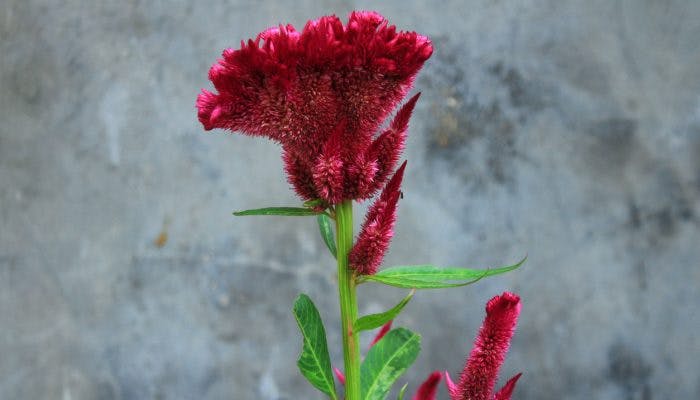Cockscomb Flower

What is Cockscomb Flower?
Cockscomb Flower (ji guan hua, 鸡冠花), also known as Flos Celosiae Cristatae, refers to the inflorescence of Celosia cristata, which belongs to the Amaranthaceae family. These large, bright coloured and cauliflower-shaped flowers resemble a rooster’s comb, which is how it got its Chinese name, as Ji Guan Hua means Rooster’s Comb Flower. These flowers come in a wide variety of colours from purple, pinks and violet to orange, red and crimson.
Cockscomb Flowers are harvested in August and September, where they are cut off, tied up in small bundles and dried under the sun for medicinal usage.
In Traditional Chinese Medicine (TCM), Cockscomb Flower falls under the category of ‘Herbs that stabilize and bind’. Such herbs are used to treat abnormal discharges and displacement of organs, including conditions such as diarrhoea, vaginal discharges, prolapse of the uterus or rectum.
Cool in nature, Cockscomb Flower can help individuals with too much Heat in their body, such as those experiencing a Yang Excess or a Yin Deficiency, to restore a harmonious yin-yang balance. Sweet in taste, Cockscomb Flower can slow down acute reactions, detoxify the body and has a tonic effect on the body by replenishing qi and blood. In particular, Cockscomb Flower targets the Liver and large intestines.
Functions and Benefits of Cockscomb Flower
Traditional Chinese Medicine (TCM) shows that Cockscomb Flower has the following health benefits.
Cockscomb Flower can cool blood and stop bleeding. It is indicated for a variety of bleeding disorders and other abnormal discharges from the Lower Jiao. Furthermore, as Cockscomb Flower can bind one’s intestines and clear Heat, it is also used to treat dysenteric disorders, especially chronic dysenteric disorders or those that are marked by blood.
For example, Cockscomb flower can be used to treat ulcerative colitis, urine with blood, hemoptysis, hematemesis, hematochezia due to anal fistula and metrorrhagia. In addition, the herb can consolidate jing to stop diarrhoea.
Cockscomb Flower can be used as a stand-alone herb in powder for dissolved in wine to treat incessant menstruation too. Studies have also shown that Cockscomb Flower can kill parasites.

How to Use Cockscomb Flower
The recommended daily dosage of Cockscomb Flower is 6 – 12g, when consumed in the form of pill or powders.
Cockscomb Flower can be used to make soup or tea too. For example, the herb can be used to make Cockscomb Flower and Clam soup, as well as Cockscomb Flower tea.
To treat blood disorders, it is best to use Cockscomb Flowers that are dark pink or red. To treat qi disorders, it is best to use Cockscomb Flowers that are white or yellow.
Cockscomb Flowers can be found in herbal stores and Asian specialty markets.
Cautions and Side Effects of Cockscomb Flower
Cockscomb Flower should not be used by individuals experiencing uterine bleeding due to Blood Stasis, early stages of dysenteric disorders with Exterior signs, or Damp-Heat.
It is also not advisable for those with diarrhoea or flu symptoms to take this herb.
We strongly encourage you to consult your healthcare provider before deciding to add Cockscomb Flower to your healthcare routine!
Summary
Here is a summary for Cockscomb Flower:
- Herb name (Chinese): 鸡冠花
- Herb name (Pin Yin): jī guān huā
- Herb name (English): Cockscomb Flower
- Herb name (Botanical): Flos Celosiae Cristatae
- Origin of species: Celosia cristata L.
- Part(s) of herb used: Flower (Capitulum)
- Geo-specific habitat(s): Many parts of China
- Taste(s) & Properties: Sweet, astringent; Cool; Administrates the Liver and Large Intestine Meridians
- Actions: Eases symptoms related to abnormal vaginal or uterine discharge; Eases bleeding conditions; Relieves conditions of chronic dysentry
References
Lv, B., Peng, Y. D., Fu, W. H., Li, W. J., Chen, L. J., & Wang, Z. (2022). A traditional Chinese medicine for the treatment of endometrial hyperplasia via regulating the HPO axis in rats. Evidence-Based Complementary and Alternative Medicine, 2022. [Accessed on 30th May 2023]
Yun-Fei, Z., & Dazhong, C. (2017). Advances in studies on pharmacological effects of Celosia CristataL. Амурский медицинский журнал, (4 (20)), 95-96.[Accessed on 30th May 2023]
Share this article on
